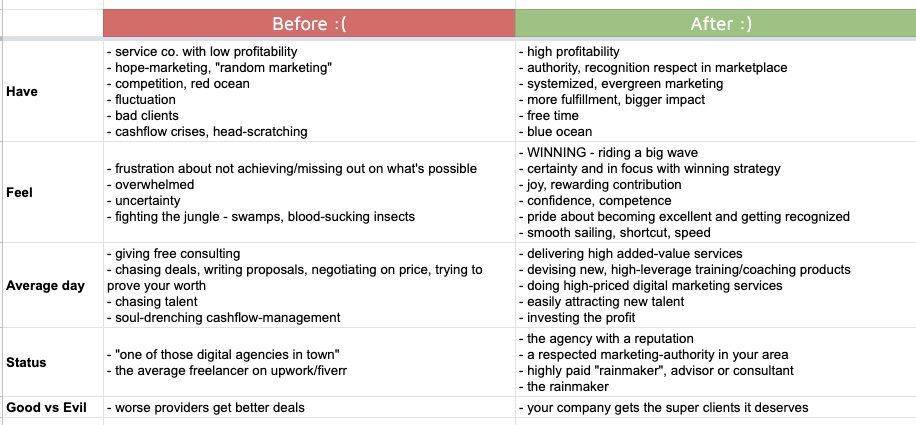This episode will help you to use emotion wisely in sales and marketing of IT services and tech products. Even if you think your service or product is dull. Ask any great sales person the turning moments in memorable sales conversations.
They will almost always talk about the prospect experiencing strong emotion: a realization, bonding, connecting with a story. Key turning points, aha moments always happen when emotion is spurred, injected into the conversation.
If spurring emotion in sales is so powerful, imagine what it will do to your marketing! Most marketing material focuses on facts. One step beyond describing a product or a service is to focus on benefits. However, if you want to take it a step further, you’ll incorporate outcomes, results and experiences in your copy.
Realizing that no matter what your product or service does, it impacts actual people at the end of the day should be a game changer in how you approach marketing. Give weight to the outcomes experienced by your buyers. That’s where emotion comes into the picture.
Key take-aways:
- Why you want to use emotion consciously: it’s the best way to manufacture connection and trust and be authentic
- How to use emotion in your marketing
- The single most important emotion you want to your prospects to experience.
- Two ways of mining and unlocking emotions to use in marketing
Just because you sell “serious” and intangible things doesn’t mean you can’t use emotion.
There are a few misconceptions about emotion in marketing – myths if you will, that we need to dispel. This will make your marketing and sales connect more – using emotion consciously.
Myths about using emotion
These myths are inspired by the article by Jane Flemming – we stole a few from her and added our own myths with common misconceptions based on our experience in the B2B tech space.
Myth 1: Facts and emotions are mutually exclusive
In decision making, people rationalize their emotions much of the time with facts.
Example:
CIO Susan buys an IT solution because the brand is trendy with a great reputation. The brand has successfully bonded with the buyer; Susan trusts them.
Susan doesn’t even go into great depths about comparing its features with competitors’.
The other CIO, Sally opts for a solution because it is cost effective, is supported by the CEO and she speculates that if things were to really go wrong at implementation, this choice is the safest.
Question: which decision was dominated by emotion: Susan’s or Sally’s? The answer is both. In the first case, it’s an easy call. In Sally’s case, the fear of uncertainty, a low risk-tolearnce and the fear of failure are just as strong emotions, although they’re often bundled and buried under the disguise of rational arguments.
It’s an old adage that people tend to post-rationalize their emotional decisions.
All this is great news, if you know how to put it to your advantage. First, let’s bust some myths around using emotion.
Myth 2: you can’t use (or express) emotion and remain professional
Emotion does not equal drama. When done correctly, it’s like seasoning with cooking – so subtle you hardly even notice it, but the end result, the overall experience is very memorable. There are good ways and poor ways to go about using emotion in your marketing.
Myth 3: you only need to focus on connecting on an emotional level
Some people have the misconception that connection and persuasion only happen on an emotional level. Not true. You often shouldn’t start the conversation (whether in-person or in marketing materials) with emotion. Especially in problem-aware markets it is often facts and tangible things that get the attention and spark interest.
Going straight for emotion can sometimes weaken your message.
Myth 4: using emotion is manipulation
It can certainly be misused. However, using emotion in itself is not manipulation. How do you know when you cross the line into manipulation? When you disregard the client’s interest and place your immediate interest above it. As a result, you withhold information, you “color” things differently and you have a bad gut-feeling in general.
One can just as easily mislead people by using facts selectively.
Use Story to connect on a deeper level
Have a brand narrative. Use the Storybrand framework or read one of Robert McKee’s thick books, Story.
When you’re taking the hero (client) on a journey with you and act as their guide in helping them fulfill their mission. Take into account:
- Desired identity – your hero (buyer persona)
- External, internal, and philosophical problems.
How to uncover emotional drivers: the before-after matrix
Describe the differences between the lacking-negative “before” state to the positive, value-filled “after” state. Use the Before-After Matrix pioneered by DigitalMarketer. It uses “before-after” transformation on five levels. Here is an example for a service company, an imaginary agency:

The most important emotion to evoke
In general, the most important feeling you want your prospect to experience after talking to you is: competence. This surprises people because they tend to think the more confusing they are, the smarter they will look and thus the easier they’ll sell their solution.
If you manage to evoke the feeling of “I can do this” and minimize the feeling of overwhelm associated with complex products, you will create a strong bond. The feeling of overwhelm is the no. 1 underlying factor in deals being postponed in cases where the prospect has the budget and the need for the solution.
If you think about it, a major part of many successful tech brands’ success was making something complex easily accessible and attainable:
- Salesforce got rid of the dependence on IT and complex hardware
- HubSpot created an all-in-one, no-hassle CRM-marketing-customer success platform for SMBs
- Slack simplified communication and messaging
- Trello gave people an alternative to the behemoth MS Projects or Redmine while being versatile enough for semi-complex projects.
Motivating and inspiring the buyer is also an important objective in marketing, but in our experience, the feeling of “we can do this” and “this will work” moves the needle more than any other motivating or inspiring factor.
Related Posts
- The simple B2B growth-marketing play - ep 3
Can you have success with almost zero marketing? Some believe it’s possible. Up to a…
- The greatest content marketing opportunity in B2B - ep 25
Have you heard the news of the B2B company that went bankrupt because it created…
- How B2B Marketing is Changing - ep 26
Marketing is being flipped on its head, and most players don't even realize it. All…

